|
OUTDOOR RESEARCH ZENITH GLOVES
TEST SERIES BY CHRISTOPHER NICOLAI
LONG-TERM REPORT
May 01, 2009
CLICK HERE TO SKIP TO THE FIELD REPORT
CLICK HERE TO SKIP TO THE LONG-TERM REPORT
TESTER INFORMATION
|
NAME:
|
Christopher Nicolai
|
|
EMAIL:
|
thebootfitters at yahoo dot com
|
|
AGE:
|
34
|
|
LOCATION:
|
Seattle, Washington & Minneapolis, Minnesota
|
|
GENDER:
|
M
|
|
HEIGHT:
|
5' 11" (1.80 m)
|
|
WEIGHT:
|
172 lb (78.00 kg)
|
|
WAIST:
|
33" (84 cm)
|
|
CHEST:
|
40" (102 cm)
|
|
NECK:
|
15" (38 cm)
|
|
SLEEVE:
|
34" (86 cm)
|
I have been backpacking for 10+ years in locales from Chile to Alaska. I have experienced temps from -30 F (-34 C) to 100 F (38 C), heavy precipitation in virtually all forms, and winds exceeding 75 mph (120 km/h) - in everything from desert to rainforest to glaciated peaks. Most of my trips are 1-4 nights climbing/backpacking less than 15 miles/day (24 km/day) in the Pacific Northwest mountains or canoeing in Northern Minnesota. I prefer to pack a tarp and minimal gear -- less than 20 lb (9 kg) -- for backpacking, but may carry twice that on alpine climbs or winter trips to accommodate suitable gear and shelter.
INITIAL REPORT
PRODUCT INFORMATION & SPECIFICATIONS
Manufacturer: Outdoor Research
Year of Manufacture: 2008
Manufacturer's Website: http://www.outdoorresearch.com
MSRP: $159 US
Listed Weight: 9 oz (255 g) for Size Large Pair
Measured Weight: 8.8 oz (250 g) for Size XL Pair
Shell Glove: 2.5 oz (72 g)
Liner Glove: 1.9 oz (53 g)
Measured Dimensions of Shell Glove
Cuff to tip of middle finger: 13.5" (34.3 cm)
Length of middle finger: 4.25" (10.8 cm)
Seam-to-seam across wrist: 5" (12.7 cm) or 10" (25.4 cm) circumference
Cuff opening: 16" (40.6 cm) circumference
Color: Black (with grey trim on the fingers -- also available Sulfur/Grey)
Size: XL (available from S to XL)
Country of Manufacture: Sri Lanka
Guarantee: All Outdoor Research products are backed by their Infinite Guarantee: "Outdoor Research products are guaranteed forever."
INITIAL IMPRESSIONS
Outdoor Research describes the Zenith gloves as a "durable and lightweight shell system for mixed ice and technical climbs." Upon initial inspection, the Zenith gloves appear to be a durable and versatile glove system built to withstand some rugged field use. The liner gloves have a soft, comfortable interior, and seem to offer good dexterity for a soft shell glove.
According to the sizing chart on the Outdoor Research website, the recommended size for my hands is a large. Since I generally prefer a slightly loose fit in order to avoid the constriction of blood flow, I feel the extra large size gloves fit me quite well.
BASIC CONSTRUCTION & DESCRIPTION
The gloves were shipped just as I've seen Outdoor Research gloves displayed in retail stores, with a hangtag describing the technical features of the gloves in French and English (see picture). Another hangtag featured Ventia, Outdoor Research's proprietary waterproof/breathable material used in the shell of the gloves.
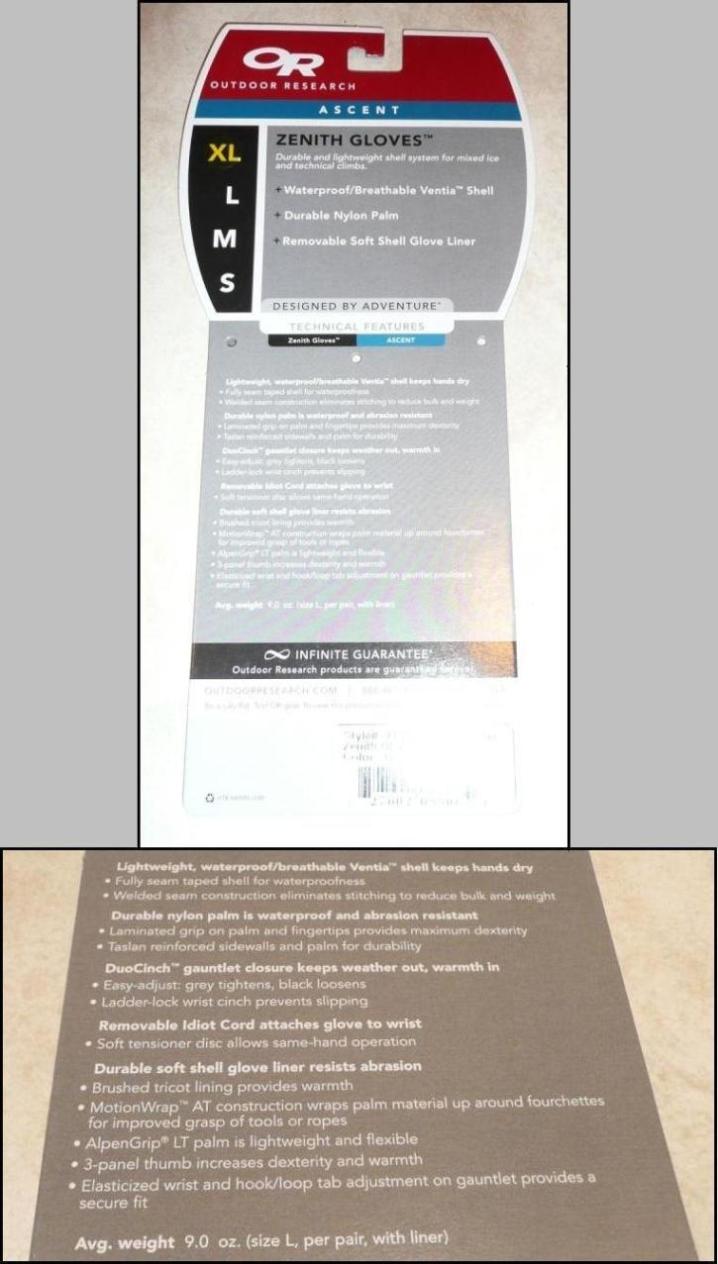 | | Product Hangtag (with zoom) |
The Zenith glove system consists of a fully seam-taped nylon outer shell (with a waterproof/breathable Ventia membrane) and an inner soft shell liner glove with a soft tricot lining and a grippy rubbery/leathery material in the palms and interior portions of the fingers.
The shells have a mini quick-release buckle to keep the two gloves together when desired. They also have a small loop of flat shoelace cord to which a longer loop of cord is girth-hitched. Outdoor Research calls this their "Idiot Cord." It is designed to fit around the wrist of the wearer with a small disc that slides to tension the cord around the wrist and prevent the gloves from getting lost -- even when the wearer temporarily removes the gloves from the hands.
A flat piece of webbing passes through a simple ladder-lock buckle to allow the wrist to be cinched snugly if desired. Two cords extend from the cuff of each glove. These make up the "DuoCinch" system: the end of the cord with the gray toggle tightens the cuff, while the black toggle loosens the cuff.
The liner glove has a band of elastic on the bottom side of the wrist and a hook & loop adjustment tab to tighten the fit around the wrist if desired.
The palms and finger tips of the shells have a textured, grippy material laminated to them. This material appears to be placed not only to provide a better grip than the nylon shells would allow, but also reinforcement to the areas of the gloves that are likely to see the most wear.
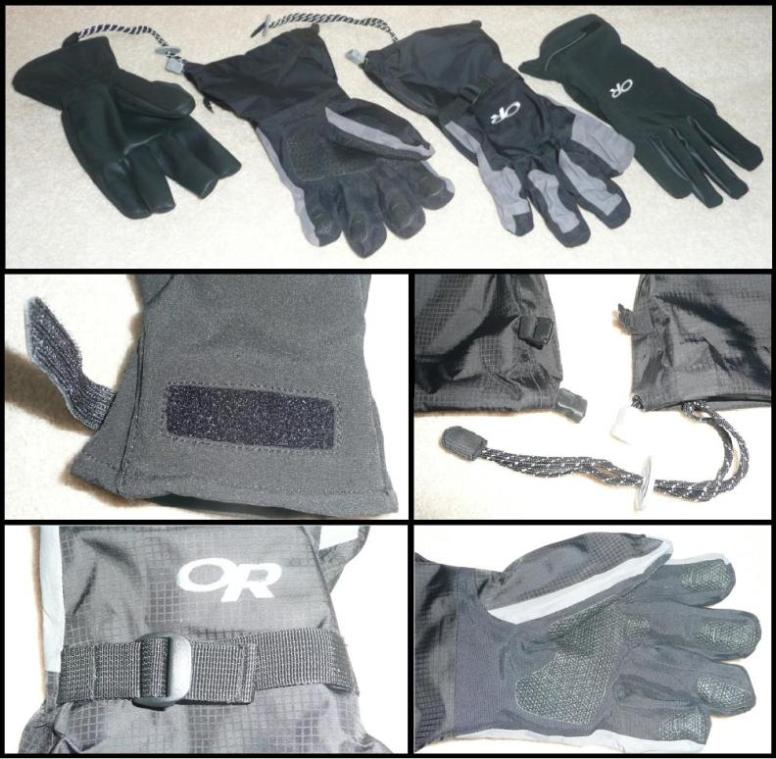 | | Zenith Gloves |
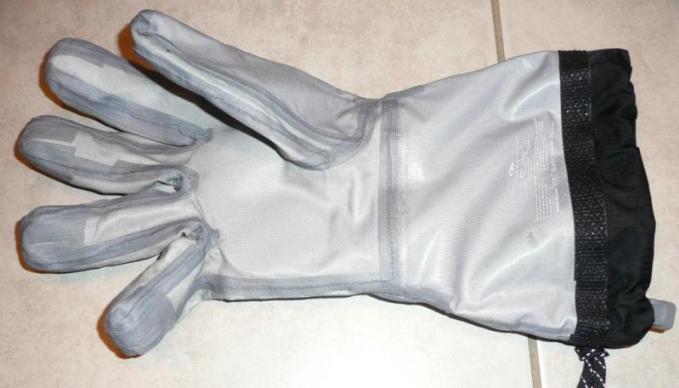 | | Shell glove turned inside-out |
TRYING THEM ON & TRYING THEM OUT
Trying them on...
------------------------------------------------
The Outdoor Research website has a sizing chart to help the consumer determine the appropriate size to purchase. Per the measurement instructions, the circumference of my hand measures 9.25" (23.5 cm) and the length is 8.25" (21.0 cm). The chart recommends a size large for a hand with these measurements, but I am glad that I was sent the extra large gloves. I do not like a snug-fitting glove, since this typically restricts the flow of warm blood into the hands and fingers -- making my hands colder than they would be otherwise. While I sacrifice some degree of dexterity by having slightly looser fitting gloves, my priority -- especially for this type of glove -- is warmth. With that in mind, I feel that the size extra large fits me very well.
The liner gloves alone are very comfortable. I anticipate that I'll often use these alone for everyday gloves on my walks to work in Seattle and while driving a cold car in Minnesota. I do not feel any tightness around any of the fingers or around the wrist.
The shell gloves alone over bare hands also are relatively comfortable. Because the seams are all taped, the stitches are all covered. (Which also means there are no loose threads to snag on anything!) My hands do not feel constricted inside the shells. I can envision wearing these comfortably alone or with a thin liner glove while hiking in cool temperatures in the rain.
When trying on the softshell liners inside the shell gloves, I felt a bit of restriction between the fingers. As you can see in the picture below, some of the shell material is bunching between the fingers. The thickness of the softshell liner appears to be just enough to make the fit between the fingers just a little tight. Given that the shell material is new and somewhat stiff, I suspect that this tightness will diminish with continued wear over time. However, it is something that I'll watch throughout the testing period.
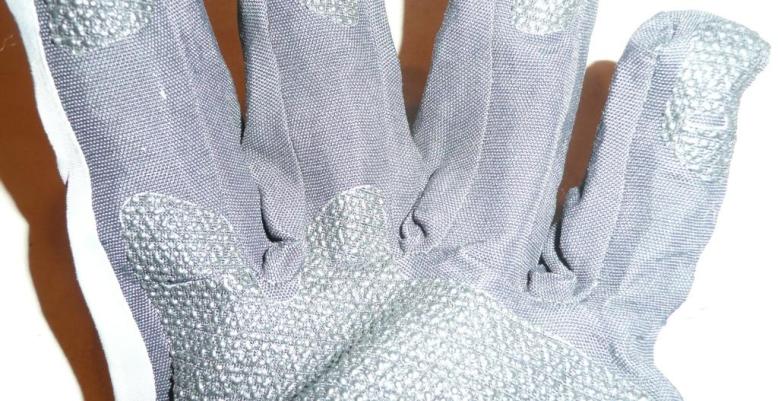 | | Bunching of material between fingers... |
Trying them out...
------------------------------------------------
I put just the shell glove on my right hand and placed it under the spray faucet in my kitchen sink for a full two minutes. As expected, I experienced no leaking and my hand stayed completely dry inside the glove.
I then tried the same test with just the softshell liner glove. The water was beading up and shedding off the backs of the gloves. In the palms, the water didn't bead up quite as much, but still seemed to be shedding off the gloves. After about a minute, I started to feel a bit of dampness around the seams of the fingers. Given that the liner gloves are not advertised as fully waterproof and are not taped along the seams, I feel that their performance in this controlled experiment is acceptable.
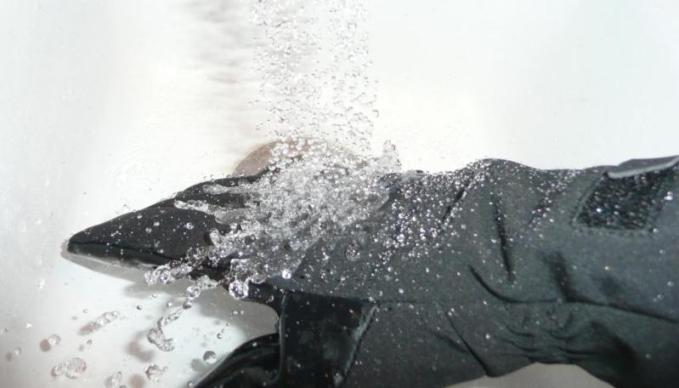 | | The kitchen sink spray test! |
I have taken the gloves with me on two hikes so far, but only used the shell gloves for a matter of minutes at the high point (read: cold point) of each trip before turning around to go back down. They worked well for these two brief instances, and I'm looking forward to giving them a more thorough test over the coming months!
FIELD REPORT
FIELD LOCATIONS AND CONDITIONS
I have used these gloves nearly every day in some capacity since the beginning of the testing period in early December.
* They have seen the most wear while walking to and from my bus stops in an urban setting in Seattle, Washington on cool or cold days. Temperatures have ranged mostly between 30 F and 45 F (-1 C and 7 C). I have experienced precipitation in the form of light to moderate rains and snow on many of these days.
* I spend approximately 20% of my time in Minneapolis, Minnesota, and have also used the gloves on a regular basis in the urban environment there. Temperatures have ranged mostly between -10 F and 35 F (-23 C and 2 C) during my time using the gloves in Minneapolis. I have experienced snow falling during some of my visits.
* I used the gloves while skiing on at least ten occasions and sledding on four other occasions, either in the Cascade Mountain Range in Central Washington or in Southern Minnesota. Temperatures during these outings have ranged between 10 F and 35 F (-12 C and 2 C). Snow has fallen intermittently during some of these outings. Winds have gusted as high as 25 mph (40 km/h) on some occasions.
* I have used the gloves on two snowshoe outings in Minnesota thus far, including a multi-day excursion into the Boundary Waters Canoe Area of Northern Minnesota. Temperatures have ranged between -20 F and 10 F (-29 C and -9 C). Light snow has fallen during some periods of these outings. Winds gusted as high as 15 mph (24 km/h) on some occasions.
* I have used the gloves on two day hikes into the Cascade Mountain Range in Central Washington, with temperatures ranging between 10 F and 32 F (-12 C and 0 C). Snow fell intermittently during one of these outings, and wind was a significant factor as well -- gusting as high as 30 mph (48 km/h).
PERFORMANCE IN THE FIELD
Partly due to the fact that the soft shell liners inside of the outer shells are tight around the base of the finger, and partly due to the fact that I do not need a waterproof shell for a good portion of my uses, I have used the soft shell liners more frequently than the outer shells. Still, the outer shells have come in very handy for retaining heat on a number of occasions when the wind has picked up.
I have been using both the soft shell and outer shell in conjunction as much as possible in an attempt to loosen up the bulky seams of the outer shells; however, I have not yet noticed any significant change in the tightness around the base of the fingers when using the two gloves together.
AROUND TOWN
---------------------------
The soft shell liner gloves have performed admirably around town, while walking, biking, driving and just standing around waiting for the bus on a cool, rainy day. They offer plenty of insulation and protection from the elements for this type of wear. I have been impressed at the level of dexterity I have with the soft shell liners on: I frequently operate my cell phone buttons with surprisingly few mistakes.
WHILE SKIING
-------------------------
When I am riding the lifts, I generally find that the soft shell liner gloves offer sufficient insulation as long as the temperatures stay above roughly 20 F (-7 C) and the wind remains light. When the winds pick up or the mercury dips below this level, I typically find that I need to break open a chemical hand warmer to stay comfortable. I have attempted to pull the outer shells over the soft shell liners on a number of occasions, but my initial and long term perception has been that my fingers feel even colder with the outer shells on over the soft shell liners.
When I am propelling myself up the slopes instead of riding the lifts, I find that the soft shell liner gloves are generally too warm until the temperature drops below 20 F (-7 C). When it is warmer than this, I will typically wear the outer shells in conjunction with just a thin silk liner glove. I find this combination to be very versatile for blocking the wind and/or precipitation during high activity levels or when outside temperatures are not too cold.
WHILE HIKING AND SNOWSHOEING
-------------------------------------------------------
Much like when I am skiing, I often use the soft shell liner alone or the outer shell in conjunction with a thin silk liner, depending on my activity level and the conditions.
On one particular outing with ambient air temperatures around 20 F (-7 C) and little wind, I performed a small experiment. After hiking for long enough to get warmed up all over, I donned just the soft shell liner gloves and hiked another 10-15 minutes. I noted that my hands were a comfortable temperature. I then put on the outer shell over the liners and hiked another 10-15 minutes. I noted that my fingers all felt cool or cold. Though I lack the equipment to measure blood flow and heat retention, the difference in my perception of warmth was profound. The most likely driver of this difference, in my estimation, is the tightness felt at the base of the fingers, which restricts the circulation of warm blood to the finger tips.
On my most recent outing, the wind was generally very light and ambient air temperatures dropped to approximately -2 F (-19 C) for the initial hike in. Because of my high level of activity -- hauling roughly 50 lb (23 kg) of gear in a pack and a sled -- I found the soft shell liners to be sufficiently warm for this venture. Only when I stopped to check the map or eat a snack did my fingers begin to get cold. When the wind increased, I found myself curling my bare fingers together in a fist inside the palm of the glove to stay warm.
AN UNFORTUNATE TEAR AND A SPEEDY RESOLUTION
----------------------------------------------------------------------------------
On a recent ski outing, when removing the shell glove from the liner glove underneath -- and with the Idiot Cord attached to my wrist -- the laminated seam around the cuff of the glove ripped open at the point where the "idiot cord" was attached. Fortunately, this ripped seam did not render the gloves useless for the day, but it was disappointing, nonetheless.
After returning from the ski outing, I called Outdoor Research's customer service number from their website. I explained what had happened to the gloves and that I was planning to leave town for a multi-day trip during which I was hoping to use them. They indicated that the estimated repair time was at least two weeks, but since I happened to live in Seattle, I was welcome to stop into the Outdoor Research Company Store on First Avenue and exchange the gloves for a new pair there. I took advantage of my proximity to the store, and that's just what I did. After explaining the situation, I received a brand new pair of gloves with no hassle.
Though it was unfortunate that the gloves experienced the ripped seam, Outdoor Research stood behind their product and offered a very satisfactory and speedy resolution. The biggest drawback to this experience, in my estimation, is that I have to start all over breaking in the bulky seams on a new pair of shell gloves. On the bright side, this particular pair seems to be slightly less constricting around the fingers than the first pair I had.
(Note: Due to my tight timeframe between the outing when the seam ripped and when I exchanged them at the Outdoor Research store, I did not think to take a picture of the seam before the gloves were out of my possession.)
SUMMARY
My overall experience with these gloves thus far has been stellar. The fit of the soft shell liners is precise and very comfortable for a wide range of uses. The grip of both the soft shell liners and the outer shells has proven to be secure while handling skis, poles, sleds, and other equipment. Though many factors influence perceived warmth, I have been able to wear the softshell liners comfortably as low as -2 F (-19 C), as long as my activity level remains high.
The only real disappointments I've experienced with the gloves thus far have been the fit of the outer shells in conjunction with the liners and the blown seam that Outdoor Research promptly addressed. I'm still hoping that after extended use, the outer shells will loosen up. And I'm hoping that the blown seam was simply a fluke.
LONG-TERM REPORT
LONG-TERM TEST LOCATIONS AND CONDITIONS
* I have skied with these gloves (liners and/or shells) another eight times in the Cascade Mountain Range in Washington State, in Southern Minnesota, and in Southern Alaska -- including one outing that included skinning up on my skis approximately 2,000 ft (600 m) starting from 4,000 ft (1200 m). Temperatures have ranged between 10 F and 50 F (-12 C and 10 C). I have experienced precipitation in the form of light to heavy rain and snow on five of these occasions.
* I spent a morning ice climbing with the gloves in Saint Paul, Minnesota. Temperatures hovered just above the freezing point, melting the ice and creating wet conditions. The sky was partly cloudy and a light breeze was blowing.
* I used the liner gloves alone while sledding and using a rope tow in Saint Paul, Minnesota. Temperatures were approximately 20 F (-7 C) and there was not a cloud in the sky.
* I used the gloves (liners and shells together) while constructing an igloo near White Pass in the Cascade Mountain Range in Washington State. The ambient air temperature was approximately 50 F (10 C), but the sky was clear and the sun was very warm, which caused the snow I was handling to be very wet.
* I have also continued to use the gloves around town in temperatures between 30 F and 45 F (-1 C and 7 C) until the temperatures and conditions no longer warranted their use.
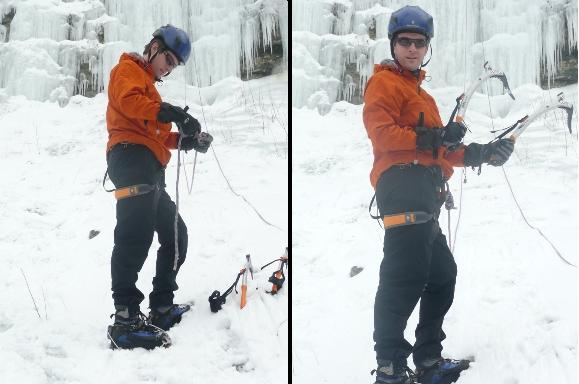 | | Ice climbing in Minnesota |
 | | Skiing at Mount Baker |
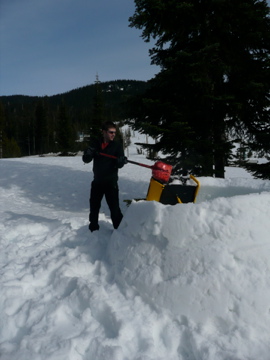 | | Igloo building at White Pass |
PERFORMANCE IN THE FIELD
I have continued to be quite happy with the overall performance of these gloves, though I do have a few noteworthy observations.
After continued wear, I feel that the seams in the fingers of the shell gloves have loosened up a bit, though they are still tighter than I would prefer with the soft shell liners worn on the inside.
Only once did I feel any significant amount of moisture inside the shell gloves while wearing them in the field. This happened while wearing only the shell gloves (no liner of any sort underneath) while building an igloo in temperatures several degrees above freezing. Not only was the snow very wet and a lot of snow flying around, but my hands were sweating too. I could not determine in the field the source of the moisture I felt inside the gloves; however, regardless of the source, the moisture ended up causing my hands to feel cold (despite the relatively warm temperatures) as I continued to handle the wet snow.
I decided to replicate the kitchen sink test that I performed at the beginning of the testing period and described in the initial report. With the shell gloves on, I noticed quite a bit of moisture penetrating the inside of the right-hand glove after approximately two minutes under the faucet. (The left-hand glove was dry inside.) I turned the glove inside-out, but a careful inspection did not reveal any visible punctures, tears, abrasions, or any other compromise in the fabric. With the right-hand shell still inside-out, I filled it with water, held it up and watched for visible signs of leaking. Almost immediately, I saw water droplets forming at the finger tips. The water appeared to be seeping out along the welded seams on the sides of the fingers and at the point where the seams were bunched together at the finger tips.
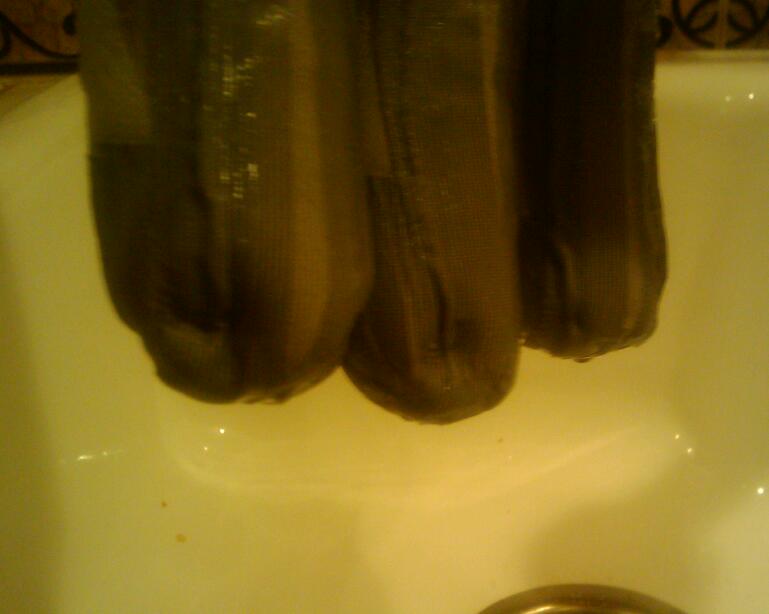 | | Shell glove leaking |
The soft shell liner gloves performed about the same as they did in the initial test: shedding water and keeping my hands dry until I felt a bit of moisture seeping in after about a minute under the kitchen sprayer.
While Ice-Climbing
------------------------------
These gloves worked well for use while ice-climbing. I felt I was able to handle the tools well and grip them easily. I did notice that I lost a bit of dexterity with the combination of the shell and liner glove compared to just one or the other. It took just a bit longer to cinch the straps on the ice tools with both the liners and the shells on. I felt I had the best dexterity while wearing just the liner glove.
While Using a Rope-Tow
-------------------------------------
I went sledding one day with just the liner gloves on my hands. I have been impressed with the amount of grip that the soft shell liners have in the palm of the glove. The soft, synthetic material grips things very well! However, a drawback to this soft material is that it is less durable than a harder material might be. On one trip up the hill, I grasped the rope attached to the rope-tow. I inspected the glove at the top and noticed several abrasions where the rope had slid through my fingers. Nothing abraded all the way through the glove, but it was definitely a noticeable change.
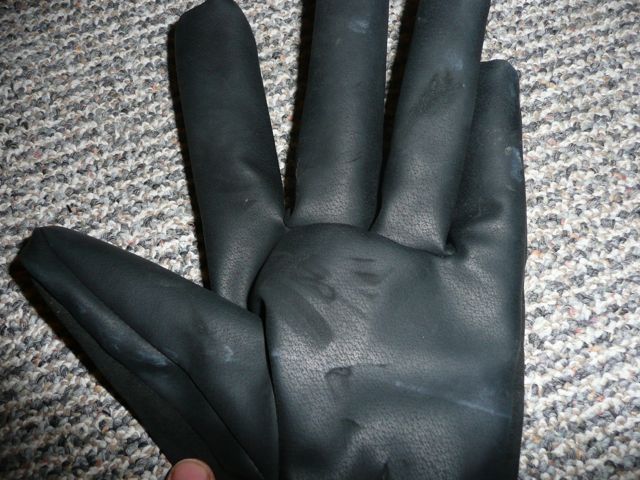 | | Abrasions from rope tow |
CONTINUED USE
I have enjoyed using these gloves, and they have performed well for me for the most part -- particularly the soft shell liners. I will most definitely continue to wear the liners, much as I have worn them throughout the testing period. I am a bit disappointed in the performance of the shell gloves, though. First the seam tear (which may have been a fluke) and then the leaking. I would like to continue wearing them, though if I am going to wear waterproof shell gloves, my preference is that they actually be fully waterproof. Because I like most other things about the shells, I will contact Outdoor Research to see if I can replace the shells and keep the liners.
This concludes my report for the Outdoor Research Zenith Gloves. Thank you for reading! And many thanks to BackpackGearTest and Outdoor Research for the opportunity to participate in this test!
This report was created with the BackpackGearTest.org Report Writer Version 1.
Copyright 2009. All rights reserved.
Read more gear reviews by Christopher Nicolai
|




